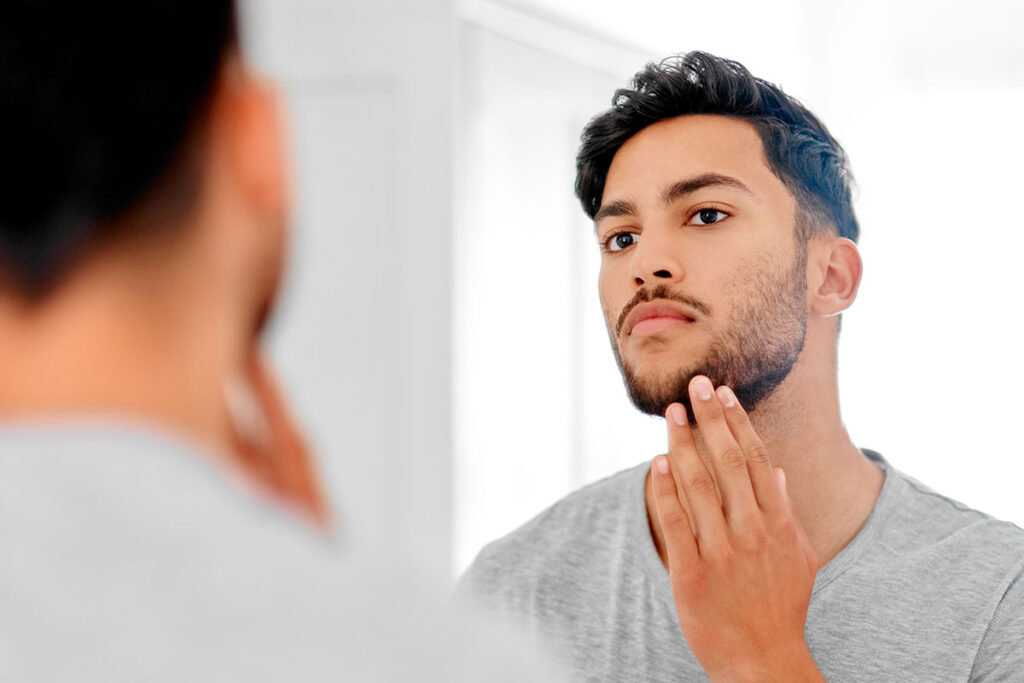If you’ve recently undergone a beard transplant, you may be eager to see your new look take shape. However, while the procedure itself is a significant milestone, the actual results depend on how well you care for your skin afterward. Proper skincare after a beard transplant helps ensure that your grafts heal properly, your skin remains healthy, and your beard grows in as naturally as possible. With the right habits, you can optimize your outcome.
At Facial Plastic Surgery Miami, Dr. Anthony Bared, our double board-certified facial plastic surgeon and hair restoration specialist, emphasizes the importance of diligent aftercare. With extensive training in otolaryngology and facial plastic and reconstructive surgery, Dr. Bared has helped countless patients achieve natural, lasting results. Below, you’ll learn the essential steps for the best skincare routine after a beard transplant.
Clean the transplanted area with care
In the first week after your beard transplant, cleaning is one of the most important steps. Gentle cleansing keeps the area free from dirt, excess oils, and dried blood that could otherwise lead to infection or poor healing. Start by rinsing the area lightly with lukewarm water (never hot or cold) to avoid shocking the follicles. Use a saline solution or mild, fragrance-free cleanser applied with a soft cloth or your fingertips. Cleaning your skin two to three times daily will help it stay fresh.
Prevent infection with strict hygiene
Your skin and follicles are in a vulnerable state after surgery, making infection prevention a top priority. Avoid touching the transplant area with unwashed hands and steer clear of surfaces or products that might harbor bacteria. Applying a thin layer of antibiotic ointment, if recommended by Dr. Bared, can help keep the skin protected. You should also closely monitor for warning signs, such as swelling, redness, or unusual discharge, and report these promptly.
Keep your skin hydrated and moisturized
Moisture is key to supporting healing and minimizing discomfort. Hydrated skin reduces irritation, promotes elasticity, and creates the right environment for hair follicle growth. Non-comedogenic, fragrance-free moisturizers with soothing ingredients like aloe vera, hyaluronic acid, or vitamin E are excellent choices. Apply your moisturizer two to three times daily to prevent dryness and flaking. If you prefer natural options, oils like jojoba can offer added nourishment; just use them sparingly to avoid clogging pores.
Protect your skin from the sun
Newly transplanted follicles and healing skin are highly sensitive to UV damage. Direct sun exposure too soon can irritate your skin and even cause long-term harm to the grafts. For at least two weeks, avoid outdoor activities during peak sunlight hours. Once your skin has healed, apply a broad-spectrum, non-comedogenic sunscreen with an SPF of 30 or higher. Wearing a hat or scarf for extra coverage is another effective layer of protection. Safeguarding your skin from UV exposure ensures optimal growth and healthier results.
Manage scabs and crusting gently
Scabbing is a normal part of the healing process and typically appears within the first week of surgery. While it may be tempting to scratch or peel scabs, doing so can damage grafts. Allow scabs to fall off naturally within 7 to 10 days. If they persist, soften them by soaking the area with lukewarm water before gently patting dry. Light application of a soothing moisturizer or oil can further ease tightness and prevent irritation. Patience really pays off, as gentle handling of scabs ensures a smooth recovery of the skin.
Focus on proper sleep and rest
The way you sleep directly affects your healing. In the early days after your transplant, elevating your head with extra pillows helps reduce swelling and prevent excess pressure on the grafts. Sleeping on your back rather than your side or stomach also helps avoid accidental friction. Using a soft, clean pillowcase helps minimize irritation and reduces the risk of infection.
Avoid strenuous activity and harmful habits
Physical activity that causes sweating or strain should be avoided for at least the first couple of weeks. Exercise increases blood flow to the face and can raise the risk of dislodging grafts or prolonging inflammation. Similarly, habits like smoking and alcohol consumption interfere with healing. Smoking restricts blood vessels and reduces oxygen supply, while alcohol dehydrates the skin and increases irritation. By pausing these habits during recovery, you’ll protect your results and help your new beard grow in stronger.
Maintain long-term skin and beard health
Once the initial healing period is over, ongoing care will keep your skin healthy and your beard vibrant. Incorporate gentle exfoliation into your routine to prevent clogged pores and keep the skin beneath your beard clear and healthy. High-quality beard oils or serums with ingredients like castor, argan, or jojoba can also condition the follicles and encourage growth.
Your beard transplant results depend as much on your aftercare as on the surgery itself. By following a routine that includes gentle cleansing, infection prevention, hydration, sun protection, and mindful lifestyle habits, you give your grafts the best chance to thrive. Dr. Bared, board-certified in both facial plastic and reconstructive surgery and otolaryngology, guides every patient through these vital steps to ensure natural, lasting results. Schedule your consultation today.


